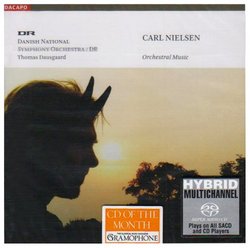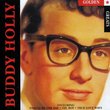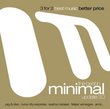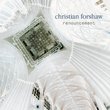| All Artists: Carl Nielsen, Thomas Dausgaard, Danish National Symphony Orchestra Title: Carl Nielsen: Orchestral Music Members Wishing: 0 Total Copies: 0 Label: Da Capo [Naxos] Original Release Date: 1/1/2007 Re-Release Date: 2/27/2007 Album Type: Hybrid SACD - DSD Genre: Classical Styles: Opera & Classical Vocal, Forms & Genres, Theatrical, Incidental & Program Music, Historical Periods, Modern, 20th, & 21st Century, Symphonies Number of Discs: 1 SwapaCD Credits: 1 UPC: 747313151868 |
Search - Carl Nielsen, Thomas Dausgaard, Danish National Symphony Orchestra :: Carl Nielsen: Orchestral Music
 | Carl Nielsen, Thomas Dausgaard, Danish National Symphony Orchestra Carl Nielsen: Orchestral Music Genre: Classical DAUSGAARD/DANISH NATIONAL SO |
Larger Image |
CD DetailsSynopsis
Product Description DAUSGAARD/DANISH NATIONAL SO Similar CDs
|
CD ReviewsThis is a No-Brainer. It's the Best Current Collection of Ni J Scott Morrison | Middlebury VT, USA | 04/20/2007 (5 out of 5 stars) "Nielsen is, of course, primarily known to non-Danes as the composer of six marvelous symphonies, and there is no dearth of recordings of the whole set of them. But there aren't all that many recordings of his non-symphonic orchestral music except for perhaps the two most popular of them -- the overture to his comic opera 'Maskarade' and the evocative 'Helios Overture.' Those two works anchor this CD: the Maskarade Overture begins the disc, and Helios closes it. One is rarely likely to hear such ebullient high spirits in the Maskarade Overture. Thomas Dausgaard, who has to be considered one of the hottest conductors around these days, gets his Danish National Symphony Orchestra to play it like the exuberant pièce d'esprit that it is. And it is followed by the equally exciting 'Cockerel's Dance' from the same opera. As for the 'Helios Overture', I have always thought it one of Nielsen's greatest inspirations, describing musically as it does the sun's course through the heavens from dawn to dusk. Did you know that early afternoon is ushered in by an exciting fugue? But it the musical contents in between 'Maskarade' and 'Helios' that makes this disc all the more special. There is the prelude to 'Sir Olaf He Rides', from incidental music to Drachmann's play, a genre which engaged much of Nielsen's efforts during the years that he was associated with the Royal Danish Theater first as violinist and later as music director. The piece evokes the Fairyland of the play with grace and craft. Following this is a suite taken from Nielsen's very early (1893, rev. 1899) suite 'Snefrid', again incidental music for a theatrical production. It includes a jaunty prelude, a yearning andante, another depicting sleep (or perhaps dreams), a funeral march and a postlude. The prelude to Act II of Nielsen's opera 'Saul and David' is full of conflict and dissonance -- it precedes the scene where David plays for Saul and a messenger brings news of the depredations of the giant, Goliath. Dausgaard's talent for maintaining great beauty while limning tension is in evidence here. The worthy but rarely heard ten-minute 'Rhapsodic Overture: An Imaginary Journey to the Faroe Islands' was written near the end of Nielsen's life, after he'd finished his sixth and last symphony and in his most advanced idiom. In three sections, it paints a tone picture of a sea voyage to the isolated Faroes, a Danish possession, in the North Atlantic. It includes a quiet passage, not without its apprehensions, in which the ship sets off. One hears seabirds, the majestic roll of ocean waves that become more and more turbulent, the rising winds and a terrifying storm. There is a welcome admixture of brash and naïve folksong along the way; perhaps the sailor's singing to calm their fears? Arrival in the Islands is greeted with both pride in the crew's accomplishment and relief at reaching a safe haven. This is a startlingly effective piece of tone painting. The Prelude to Act III of 'Willemoes', a play about a Danish naval hero, is a quiet interlude describing the protagonist's love for a young girl. 'Pan and Syrinx' (1917-18) occasionally figures on concert programs outside Denmark. It depicts Pan's attraction for the nymph Syrinx, a story in Ovid's 'Metamorphosis', and the music is one of the first by Nielsen to use a large percussion section (later to figure so strongly in such works as the Clarinet and Flute Concertos), surely influenced to some extent by Stravinsky's ballet scores, although used in a style all Nielsen's own. There are also echoes of Debussyan impressionism here. One particularly striking instrumental effect is toward the end of the piece where high strings play what amounts to tone clusters during which they gradually eliminate any vibrato. The next to last selection (just before 'Helios') is Nielsen's last orchestral work, the 1930 overture 'Cupid and the Poet' written to commemorate the 125th anniversary of Hans Christian Andersen's birth. A light-hearted work, it is nonetheless in Nielsen's spiky late style. This is one of Nielsen's works I don't recall ever hearing before and I was quite taken by it. Once again I must comment on how wonderful these performances are. They are enhanced by extremely rich and vibrant sound on both the plain stereo and SACD layers. I for one would love to have a follow-up disc in which Dausgaard and his orchestra play some of Nielsen's other non-symphonic works including such pieces as the 'Saga-Drom' and 'At the Bier of a Young Artist'. Oh, and also the suite from 'Aladdin.' They have all been recorded before, but this conductor and ensemble seem to have real insights into Nielsen's sound world. Scott Morrison" Outstanding Performances D. A Wend | Buffalo Grove, IL USA | 06/22/2007 (5 out of 5 stars) "This disc of Carl Nielsen's music has as a focus his music for the theater and contains some music that is not often recorded. The disc begins with a rousing performance of the Maskarade overture and Cockerel's Dance from act 3 of the opera. This is followed by the prelude to Hr. Oluf Han Rider (Sir Oluf He Rides), written in 1906, written for a play which was composed during the rehearsals for Maskarade. The suite for the play Snefrid was composed in 1893 following the First Symphony and was his first music for the stage. The music is lyrical and charming, conveying very beautifully the love story of the play. The prelude to act 2 of Saul and David is a more familiar piece and occurs in the opera prior to the scene where David is playing for the king when a messenger announces the challenge from Goliath. The Rhapsody Overture: An imaginary journey to the Faroe Islands, the next piece of the CD, is from late in Nielsen's career (1927) and has the more advanced harmonies of the Fifth and Sixth symphonies. The short rhapsody was written for an actual visit from the remote Faroe Islands for the Royal Theater. Willemoes was for a play written to celebrate the centennial of the death of the Danish naval hero Peter Willemoes and was used as a prelude to the third act. Willemous dies in the Battle of Zealand Point during the Napoleonic War and the music Nielsen provided described the hero's love for a young girl. Pan and Syrinx is an atmospheric piece for a large orchestra that describes the tale told by Ovid in the Metamorphoses. The scoring is imaginative, particularly the various sounds of the tambourine, and aurally tells the story of how Pan attempted to seduce the nymph Syrinx and who removed herself from his advances by being transformed into a reed - the birth of the Pan pipes. Cupid and the Poet, Nielsen's last orchestral work, was written in 1930 for a play celebrating the 125th birth of Hans Christian Andersen, and is an interesting short piece somewhat reminiscent of the Fifth Symphony with the prominent use of the snare drum. The Helios Overture closes the disc and the music reminds me of the Second and Third Symphonies. The overture was written in Greece and is a celebration of ancient Greek culture with the music depicting the coming of light, the transit of the sun and its disappearance into the sea at the close of the day. The Danish National Symphony Orchestra under Thomas Dausgaard is superb and the recording clarity could not be better. This CD was an editor's choice by Gramophone magazine; it is a must for anyone interested in Carl Nielsen's music and provides a good introduction to his works. " Nielsen uncovered Larry VanDeSande | Mason, Michigan United States | 06/08/2008 (4 out of 5 stars) "Most classical listeners know Danish composer Carl Nielsen (1865-1931) -- if they know him at all -- through one or more of his six numbered symphonies, many of which have names like "The Four Temperaments" and "The Inextinguishable". Classical music commentators have often joked about that latter symphony, which is sometimes called Nielsen's greatest, and mockingly termed it the "indistinguishable" since it so sounds like the work of a dozen or so other composers of the same era.
While the music included here is not often portrayed on Nielsen recordings, most of it has been recorded before, often by bigger name conductors and bands than Thomas Dausgaard and the Danish National Symphony Orchestra. Notable recordings from the present and past of material presented here includes Neemi Jarvi's three DG recordings; those from Herbert Blomstedt, whose reserved style of presentation on a pair of EMI disks supplemented his two sets of complete Nielsen symphonies; and, perhaps best, by Gennadi Rozhdestvensky, whose Chandos recording included the big four orchestral works -- Helios overture, Saga-Dream, Pan and Syrinx, and Fantasy Journey to the Faeroe Islands as well as selections from the theater music for Alladin, which isn't represented here. Getting back to the indistinguishable comment, that claim iis especially relevant here for me. While listening to these selections, I was regularly reminded of both the lesser orchestral music of Gustav Holst and the tone poems of Antonin Dvorak. I think the reason for this is the contrapuntal sytle of Nielsen merged with his insistence on sonata form, elements that brought both other composers to the forefront of classical music. In addition, Dausgaard's advocacy is highly imaginative and committted, consistent with the better recordings of lesser known Holst, especially those recorded on the Lyrita label. For these and other reasons, I don't agree with the worldwide acclaim this recording received. It's certainly an entertainig 72 minutes of music most listeners aren't familiar with and it exposes a side of a composer that sits outside the radar for most listeners. But I'd also say that much of this music tends to sound alike and the level of variation in its creation, while above average, doesn't render this issue record of the year quality, which many claimed it was by putting it on their 2007 recordings of the year lists. For me, the only completely new discovery here was teh 13-minute Snefrid Suite for Orchestra, a four-part examination on a theme. In addition, the stereo sound (I haven't heard the super audio layer) is OK but no great shakes and no one will confuse this orchestra for one of the world's greatest. So, for me, at last hearing this recording did not live up to the hype others have heaped on it. But I didn't expect it to achieve those heights, either, so I'm not disappointed. Considering you can acquire this new for $10 or less in hybrid super audio sound, it's a good buy if you're looking for something off the beaten path but still within the traditional late romantic European framework." |




